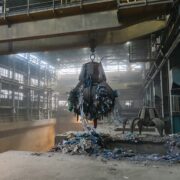Feeding artificial intelligence model with data from sensors
AI models are trained with large amounts of data. This data can be collected by sensors, such as thermal cameras, ultrasonic sensors, photocells, inductive sensors, radar sensors, LiDAR, vision camera`s and motion sensors. By combining AI models with sensors, the amount of data needed to train a model can be reduced. This is because the sensors collect the raw data, which can then be used to train and continue to train the AI model as data continues to come in.
Applications for AI combined with sensors
Here are five examples of how AI and sensors are combined:
- Industrial maintenance: AI is used to process and analyze data from sensors, such as temperature sensors, thermal cameras, ultrasonic sensors, photocells, inductive sensors, radar, LiDAR, vision cameras and motion sensors to predict and prevent machine problems.
- Sustainability: By using AI, patterns can be identified. These patterns prevent errors and reduce waste such as the finished product and the amount of power consumed.
- Smart home: AI is used to process data from sensors such as motion sensors, CO2 sensors, humidity meters and temperature sensors to control smart devices and improve the comfort of a home.
- Autonomous driving. AI is used to process data from sensors, such as cameras, radar and lidar, to drive a car without human input.
- Health Care. AI is used to analyze data from sensors, such as MRI scans and ultrasounds, to diagnose medical conditions.
Sensor Partners, as a specialist in industrial sensing and measurement issues, has a focus on the first 3 of the above categories.
5 benefits of the combination between artificial intelligence and sensors
Here are some of the benefits of combining AI with sensors:
- Improved accuracy: AI can be used to process and analyze data from sensors in a way that is more accurate than conventional methods.
- Increased efficiency: AI can be used to control and optimize sensors, allowing them to work more efficiently.
- Broadened applications: AI makes it possible to use sensors for applications not previously possible.
- Automation: AI models can be used to automate tasks currently performed by humans. This can lead to cost savings and improved efficiency.
- New opportunities: AI models can be used to create new capabilities that were not possible with traditional sensors.
The combination of AI and sensors is a rapidly evolving field. As AI technologies continue to evolve, we will see new and innovative ways to combine AI and sensors to improve the world around us.
Application example
Fire prevention: fire and fume detection in the waste management industry
Waste fires resulting from fire and scalding are an urgent and growing problem affecting both the waste management industry and society at large. These fires are caused by uncontrolled heat generation and ignition of waste materials, resulting in serious damage to infrastructure, environmental pollution and safety risks to both workers and local residents.
How is artificial intelligence used here
When a themographic camera detects a hot spot, alarms would normally go off immediately. "Detecting a hotspot is not rocket-science," said Ron van Sambeek, Manager of Thermal at Sensor Partners. "The trick is to detect the real hotspot among all the false positives that are already naturally present."
When the fire and broth detection system detects an increase in temperature, it uses AI (algorithms) to determine whether to initiate an alarm. This prevents the alarm from going off at hot spots other than an actual source of scalding or fire. For example, consider the exhaust of a passing vehicle; it radiates heat and could trigger the alarm system.
Application example
Machine Vision with AI
Machine vision is the use of computers and cameras to process and understand visual information, which is often applied in industrial automation for inspection, measurement and control. AI can no longer be ignored in these applications.
Some examples of applications of machine vision with AI:
- Quality control: AI can be used to detect defects in products. This can be done, for example, by looking at the shape, color or texture of the product.
- Process Management: AI can be used to monitor and optimize processes. This can be done, for example, by looking at the speed, accuracy or consumption of a process.
- Robot control: AI can be used to control robots. This can be done, for example, by looking at objects around the robot.
- Safety: AI can be used to detect dangerous situations. This can be done, for example, by watching for fires, spills or people standing near dangerous machinery.
Smart Sensor with AI
The potential of combining AI and sensors
The combination of AI and sensors has the potential to have a major impact on the world around us. By collecting and analyzing data from the physical world, AI can help make better decisions, solve problems and create new products and services. Sensor Partners specializes in industrial detection and measurement issues. Are these also issues that concern you? We are happy to discuss this with you.
Conclusion
Combining AI with sensors is a powerful tool that can be used to perform a wide range of tasks. However, there are some challenges associated with this technology. By addressing these challenges, we can maximize the capabilities of AI models.




